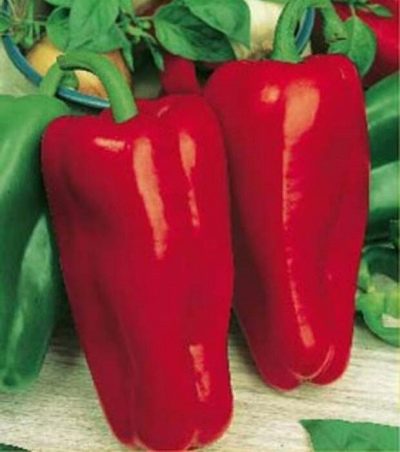
- Authors: Holland
- Bush height, cm: 100-130
- Fruit shape: rectangular-elongated
- Fruit weight, g: up to 300 and above
- Fruit color: Red
- Ripening terms: early
- Ripening month: July-September
- Fruit size, cm: 25x12
- Yield: high
- Average yield: 8-10 kg / m²
Atlantic is a variety of bell peppers originated in Holland. This hybrid has a number of features, and its main advantage is the large size of the fruits and their incredible taste, however, a high-quality harvest can be achieved only if the rules of agricultural technology are followed.
Description of the variety
This is a thermophilic variety, but Russian summer residents practice its cultivation in the northwestern regions, planting the vegetable in greenhouses. In the southern regions, the plant is usually kept in open ground. Atlantic is distinguished by high productivity and strong immunity against diseases and pests, in addition, its pulp contains a huge amount of vitamin C, and by this indicator it can successfully compete even with lemons and black currants.
Characteristics of the appearance of plants and fruits
The bush is high, spreading, reaches a height of 100-130 cm, strongly leafy. The fruits are formed in a rectangular-elongated shape, they are very large in size - 25x12 cm and weigh more than 300 g. The pulp is hidden under a red smooth skin, and the wall thickness is 8-10 mm.
Purpose and taste
The pulp of the pepper is juicy, the taste is excellent, original, fresh, bright, so it is customary to use it as an indispensable ingredient in light vegetable salad. In addition, when consumed fresh, the fruits retain their rich composition, namely vitamins of group B, PP and C, as well as trace elements.
Ripening terms
Fruits ripen from July to September, usually fruiting occurs on the 90-105th day after the appearance of the first shoots, which is typical for varieties with an early ripening period.
Yield
The Dutch hybrid is a fruitful variety and can, on average, yield 8-10 kg of peppers per square meter.
Landing scheme
Sowing time depends on the climatic conditions where the crop will be grown, usually from January to March. The grains are placed in containers according to the 7x7 cm scheme or planted in peat bags. The seedlings will feel comfortable at a temperature of + 20 ... +23 degrees, but for germination of seeds, set the temperature at +25 degrees.
When the time comes to transplant a crop to a summer cottage, give preference to places where mustard, cabbage, radishes previously grew, and avoid ridges where tomatoes were cultivated. It is best to choose a site with sandy-clay soil with a high content of organic fertilizers. Plant young bushes in a 50x50 cm pattern.

To get a large and tasty harvest of pepper, you need to take care of the seedlings in advance. When growing pepper seedlings, you need to correctly determine the sowing time, pre-sowing seed treatment, prepare the necessary container and soil.
Growing and care
This is a tall variety that requires tying or placing on trellises. It is important to eliminate excess foliage in order to enhance the development of fruits and the appearance of many flowers, but this is allowed only after harvest. If the plants grow in pairs, then one support is enough for them, to which they are tied.
The vegetable will thrive if the owner maintains a high temperature and low humidity in the greenhouse.At the same time, it is convenient to cultivate the plant together with tomatoes, since both crops love a dry microclimate. However, keep in mind that peppers are a moisture-loving plant and should be watered much more often than a tomato garden.
Favorable temperature for keeping peppers - + 24 ... +28 degrees. To make a lot of ovaries form on the plant, use a composition containing large amounts of nitrogen and calcium for feeding.

To harvest a tasty and rich harvest of pepper, you need to comply with all the conditions of agricultural technology, and proper care begins with planting plants. Before planting pepper in open ground, it should be prepared. It is also important to take care of the seedlings and planting space in advance.




For good growth of pepper bushes and active fruiting, you need to regularly apply mineral and organic fertilizing to the soil. It is necessary not only to choose the right formulations, but also to use them at the right stage in the development of culture. The frequency of top dressing is always individual. It depends directly on the composition of the land on your site. The poorer the soil composition, the more often you will need to feed the pepper.

Pepper is one of the most common vegetables in home gardens. This culture is quite stable and unpretentious. However, under certain conditions, this plant can suffer from infections and harmful insects. Before treating peppers for diseases or pests, you need to find out the cause of the problem, otherwise the treatment may be ineffective.
Review overview
The presented variety receives excellent reviews from consumers and gardeners. Summer residents like that it does not require any special difficulties in growing. The main thing is to regularly water the plant, and if the soil in the garden is nutritious, then the culture can not even be fed, so the variety is suitable for growing not only for experienced gardeners, but also for beginners.
Especially good reviews are for the taste of vegetables. According to consumers, the pulp of peppers is juicy, aromatic, sweet, and although it is stated that it is customary to eat them fresh, housewives also practice preparing preparations for the winter.





















































































